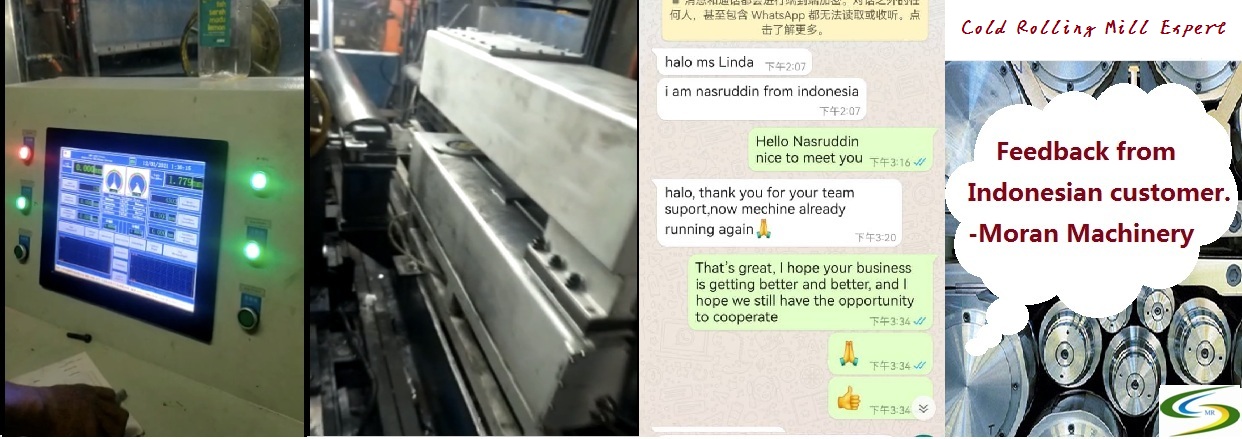Q: What is the law of minimum resistance in steel rolling technology
A: The law of minimum resistance When steel is plastic deformed, the metal flows in the direction of minimum resistance to deformation, which is called the law of minimum resistance.
Q: What is the nip and nip angle?
A: Steel rolling is to use two rotating rollers to pull the rolled parts into the roll gap for pressure processing. The roll pulls the rolled parts into the roll gap, which is called biting. The roll bites into the metal is the necessary condition for rolling. Whether the bite is smooth in actual production has direct influence on the normal operation and output of rolling mill. Large amount of pressure is not easy to bite. The pressure is small and easy to bite, but it also reduces the rolling efficiency.
When rolling, the arc of contact between the rolling piece and the roll surface is called the biting arc. The central Angle opposite the biting arc is called the biting Angle. The bite Angle is determined by the amount of pressure. In actual production, the maximum bite Angle is different under different conditions. The bite Angle is related to the surface state of roll and rolled piece, rolling temperature and roll speed, that is, the friction coefficient between roll and rolled piece. When the bite Angle is greater than the maximum allowed bite Angle, the rolled piece can not bite. When the bite Angle is less than or equal to the maximum bite Angle, the rolled piece can bite.
When the linear speed of the roll is 1.5-2.5m /s, the maximum allowable bite Angle under different rolling conditions is as follows:
Rolling condition bite Angle
Hot rolling α=27-34 on rolls with surface marks or surfacing
Hot rolling α=22-24 on section mill
Hot rolling α=15-24 on plate mill
Cold rolling α=5-6 on rough-faced rolls
Cold rolling α=3-4 on smooth and lubricated rolls
Q: How to achieve a normal nip
A: When the rolled piece is in contact with the roll, the rolled piece acts on the roll with force P, and each roll is in contact with each other as it moves, so friction force F is generated between the rolled piece and the roll. F has a component force Fx in the horizontal direction, by which the rolled piece is pulled into the roll, called Fx. The horizontal component of the pressure P exerted by the roll on the rolled part is Px, which is opposite to Fx and hinders the rolled part from entering the roll. Px is called push-out force. When Fx is equal to or less than Px, the rolled piece cannot enter the roll. Only when Fx > Px, the rolled piece can be pulled into the roll to achieve normal bite.
Q: What is the rolling reduction and reduction ratio
A: In the rolling process, the height, width and length of the rolled parts change. The reduction in height after rolling is called reduction.
namely
Delta h = h - h
△ H - pressure amount, ㎜;
H - rolling parts before rolling height, ㎜;
H - rolling height after rolling, ㎜;
Q: How can bite conditions be improved
A: Bite Angle and friction coefficient are two factors that affect the bite of roll. When the friction coefficient is constant, the biting Angle must be reduced in order to make the rolling piece bite smoothly. There are two ways to reduce the bite Angle:
1. When the amount of pressure is constant, increase the diameter of the roll;
2. When the roller diameter is constant, reduce the reduction amount. However, after the rolling mill is determined, the diameter of the roll generally does not change much, and reducing the amount of pressure is not conducive to improving productivity. In order to solve this contradiction, the following measures are adopted:
(1) when the pressure down exceeds the allowable value, the end of the rolled piece is processed into a truncated cone to reduce the bite Angle. A case in point is the use of a small head (i.e., the end with the smaller thickness) when the bloomer rolls steel ingot.
(2) Reduce the rolling speed when biting, increase the friction coefficient. Changing the rolling speed is easy to do on a dc motor driven mill, but almost impossible on most non-speed rolling mills.
(3) The use of notch and surfacing of the roll, increase the friction coefficient of the roll. However, the notch has a harmful effect on the surface quality of the rolled parts, so this method is usually used only a few times before roughing.
(4) Using impact to improve biting conditions, which is commonly known as forced feeding, is actually the front end of the rolled piece is hit into a cone under the action of impact force, so as to reduce the biting Angle.
















 WhatsApp
WhatsApp